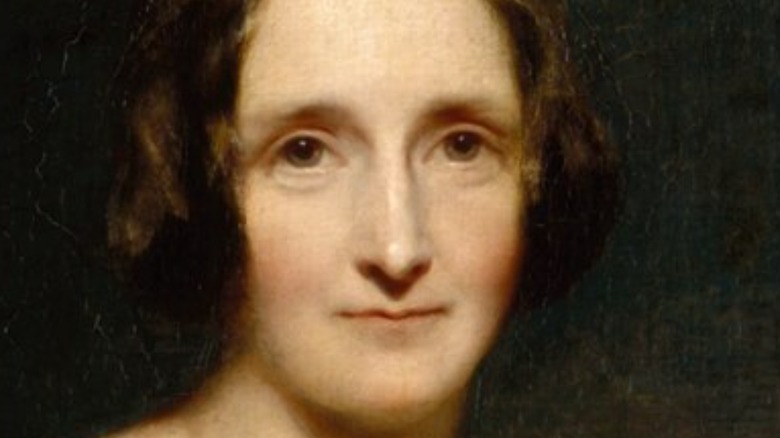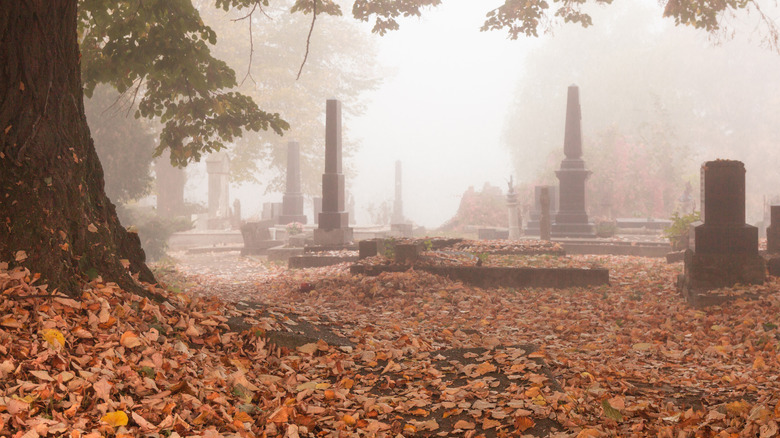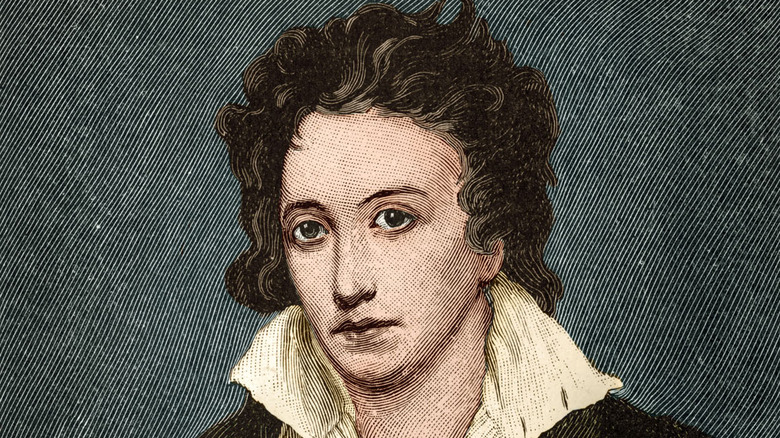Mary Shelley Reportedly Lost Her Virginity In A Spooky Place
Today, Frankenstein, or rather Frankenstein's Monster, is a staple of Halloween and the spooky world, and just about everyone can recognize the re-imagined large green ghoul with bolts poking out the side of his neck. While that's been the case for quite some time now, rewind a little over 200 years to 1818, and you'll find that the first readers of Mary Shelley's "Frankenstein" weren't too enthused with the then-controversial novel, according to The Portalist. The author herself must have seen this reaction coming, as she published it anonymously, and it remained so for the first five years of the book's life.
Mary Shelley is now one of the most famous writers to have ever lived. However, outside of her writing, she led a life filled with a unique set of events, from tragedy to forbidden love to some very macabre events. In some ways, Shelley's life is as one might expect for the writer of a sci-fi-horror novel. In other ways, her life seems like yet another story that pulls readers in and leaves them with a bit of disbelief and thought-provoking images. A part of Shelley's life that has become quite a popular story among her fans is the story of how — especially where — she lost her virginity. What might seem a strange discussion surrounding a favorite literary genius makes a bit more sense once you learn why people are so intrigued by the tale.
Mary confessed her love to the poet Percy Bysshe Shelley on her mother's grave
Mary Shelley was born in 1797 to the feminist writer Mary Wollstonecraft and the philosopher William Goodwin. According to an article published in The Portalist, her mother died just a few weeks after Mary's birth due to childbirth complications. A young Mary would visit her mother's grave often, and it's written that she used the letters carved into the headstone as a means to teach herself how to write her name, according to Profile Books.
As she grew older, the gravesite she so often visited became the spot for another piece of her life. According to some, it's the location where she supposedly lost her virginity to her love, Percy Bysshe Shelley. Charlotte Gordon, author of the book "Romantic Outlaws: The Extraordinary Lives of Mary Wollstonecraft and Her Daughter Mary Shelley," was interviewed by The Wall Street Journal in 2015. According to Gordon, "That's where we think she had sex for the first time, on her mother's grave. We can't prove that they actually had sex, but they certainly declared their love and became intimate. It was a really dangerous thing to do." Yes, Mary Shelley, famed science fiction and horror literature writer and inspiration to millions, possibly lost her virginity on her mother's grave. Profile Books points out that social media users accurately characterize the story as "the most goth thing ever."
Her father might have committed murder on her and Percy Shelley's behalf
Mary Shelley's romantic life seems like something right out of one of her own works, but the reality is that her relationship with her husband, poet Percy Bysshe Shelley, was seemingly equal parts love and tragedy. At the age of 16, Mary fell in love with Percy, who at the time was her father's apprentice. The two eloped to France, even though Percy was already married to another woman, Harriet Westbrook, according to The Portalist. The forbidden love led to Mary's father disowning her, but not before possibly committing a crime on her behalf.
It's long been speculated that Shelley's father murdered his son-in-law's wife in an attempt to salvage Mary's reputation and allow Percy and Mary to officially wed, according to Lynn Sheperd Books. Though Harriet's body was recovered in the Hyde Park River, the suspicions surrounding William Goodwin have never been met with any proof, and ultimately the death was ruled a suicide by drowning. Nevertheless, Harriet's death was something that ate away at Mary for years to come. James L. O'Rourke's book "Sex, Lies, and Autobiography: The Ethics of Confession" quotes an 1839 journal entry in which Mary wrote, "Poor Harriet, to whose sad fate I attribute so many of my own heavy sorrows as the atonement claimed by fate for her death."
Shelley's life was littered with tragedy and macabre acts of love
Perhaps Mary Shelley's draw to her mother's grave for both the experience of grief and love fit seamlessly into the rest of her life, as Shelley's days were filled with more despair than most see in a lifetime. Her mother's death just a few weeks after birth was just the beginning of death's hold on Shelley's life, as her sister died when Mary was only a teenager, and three of her four children didn't live to see adulthood, with one dying just days after birth and another dying at the age of three, according to The Portalist.
Shelley's life would continue to see dark days when her husband, Percy, drowned in the Mediterranean Sea in 1822, and her closest friend and fellow writer, Lord Byron, passed away two short years after, according to an article published in Refinery29. Shelley herself died of a brain tumor when she was 53 years old. After her passing, it was found that she'd been keeping the heart of her deceased husband, Percy Bysshe Shelley, in the drawer of her writing desk, gently wrapped in poetry and silk. The poem of choice was Shelley's own "Adonais" (posted at The Poetry Foundation), according to The Portalist. In love, life, and death, Mary Shelley lived a life filled with macabre details in every moment, whether filled with pleasure or tragedy.



